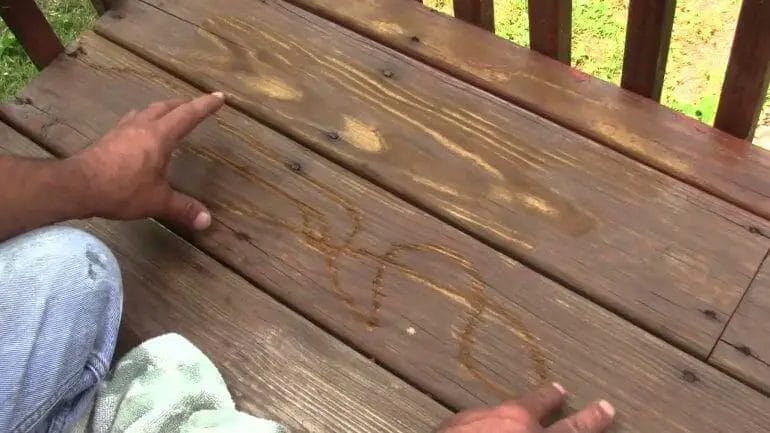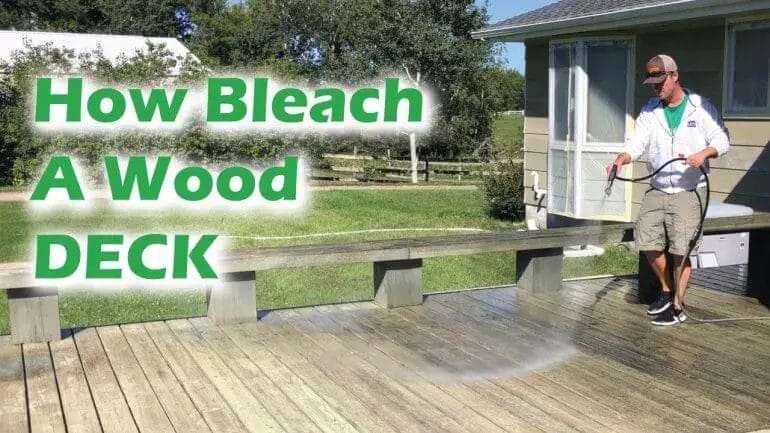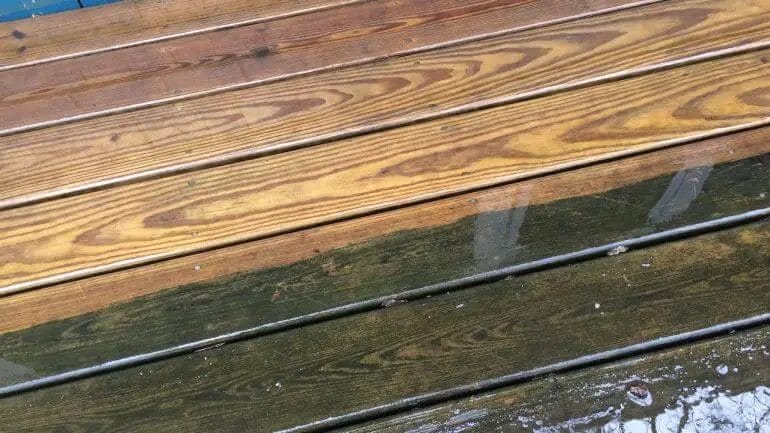If you have a wood deck, you may be concerned about whether bleach can cause damage. While bleach can be a powerful cleaner, it can also be harsh on wood surfaces. The strong chemicals in bleach can strip away the natural oils and pigments in the wood, leading to discoloration and weakening of the surface. Additionally, bleach can also dry out the wood, making it more susceptible to cracking and splintering over time. Therefore, it’s important to use caution when using bleach on a wood deck and consider alternative cleaning methods to protect its integrity.

Safe Cleaning Alternatives: Protecting Your Wood Deck from Damage
Keeping your wood deck clean is essential to maintain its beauty and prolong its lifespan. However, traditional cleaning methods that involve harsh chemicals can damage the wood and harm the environment. Fortunately, there are safe cleaning alternatives available that can effectively remove dirt and grime without causing any harm. In this section, we will explore these alternatives and provide you with useful tips to protect your wood deck from damage.

1. Vinegar and Water Solution
One of the safest and most cost-effective cleaning solutions for your wood deck is a mixture of vinegar and water. Vinegar is a natural cleaner that can effectively remove dirt, mildew, and stains without harming the wood. To create the solution, simply mix equal parts of white vinegar and water in a bucket. Apply the solution to the deck using a soft brush, scrubbing gently to lift the dirt. Rinse thoroughly with water and allow the deck to dry before using it again.
2. Baking Soda and Water Paste
If your wood deck has tough stains or grease spots, a paste made of baking soda and water can come to the rescue. Baking soda is a powerful yet gentle abrasive that can remove stubborn stains without scratching the wood. Mix baking soda with water to create a thick paste and apply it to the stained areas. Allow the paste to sit for a few minutes before scrubbing it with a brush. Rinse off the paste with water and admire the stain-free deck.
3. Oxygenated Bleach
Oxygenated bleach is another safe option for cleaning your wood deck. Unlike chlorine bleach, which can damage the wood fibers, oxygenated bleach is non-toxic and safe for the environment. Mix the bleach with water according to the manufacturer’s instructions and apply it to the deck using a pump sprayer. Let it sit for about 10 minutes before scrubbing with a brush. Rinse off the bleach solution with water and enjoy a revitalized deck.
4. Pressure Washing with Caution
While pressure washing can be a quick and efficient method to clean your wood deck, it should be done with caution to prevent damage. High-pressure water can strip away the wood’s natural oils and cause splintering. If you choose to use a pressure washer, make sure to set it to a low pressure setting and maintain a safe distance from the deck surface. Additionally, avoid holding the nozzle too close to the wood and keep it moving to prevent any concentrated damage.
5. Regular Maintenance and Prevention
Prevention is always better than cure when it comes to protecting your wood deck. Regular maintenance is key to preventing dirt and grime buildup, as well as potential damage. Sweep your deck regularly to remove leaves, debris, and dirt. Place mats or rugs at the entrances to your deck to minimize the amount of dirt and moisture that is brought onto the surface. Avoid dragging heavy furniture across the deck, as it can cause scratches and dents. Lastly, consider applying a protective sealant or stain to your deck every few years to enhance its durability and resistance against the elements.
Summary
Maintaining a clean and well-protected wood deck is essential for its longevity and aesthetic appeal. By using safe cleaning alternatives such as vinegar and water solutions, baking soda pastes, and oxygenated bleach, you can effectively remove dirt and stains without causing harm to the wood or the environment. If you choose to pressure wash your deck, remember to exercise caution and use low pressure to avoid damage. Additionally, regular maintenance and preventive measures can go a long way in preserving the beauty and durability of your wood deck. With these safe cleaning alternatives and proper care, you can enjoy your deck for years to come.

Preventive Measures: Maintaining the Longevity of Your Wood Deck
Having a wood deck can be a beautiful addition to your home, providing a space for outdoor entertainment and relaxation. However, without proper maintenance, your deck can become worn, damaged, and even unsafe over time. To ensure the longevity of your wood deck, it is essential to take preventive measures. In this section, we will discuss the key steps you can follow to maintain and protect your deck.
Regular Cleaning
Regularly cleaning your wood deck is crucial to prevent the buildup of dirt, grime, and mold. Use a broom or leaf blower to remove loose debris such as leaves, twigs, and dirt. Then, using a mild detergent mixed with water, scrub the deck surface with a soft-bristle brush or a pressure washer. Be sure to rinse thoroughly to remove all soap residue.
Sealing and Staining
Sealing and staining your wood deck is an important step in preventing damage from moisture, UV rays, and other external factors. Apply a high-quality deck sealant or stain to protect the wood and enhance its natural beauty. Before applying the sealant or stain, ensure that the deck is clean and dry. Follow the manufacturer’s instructions for the application process and reapply as needed, typically every 1-2 years.
Regular Inspections
Regularly inspecting your wood deck can help you identify any potential issues or damage early on. Check for loose or damaged boards, protruding nails, and signs of rot or decay. If you notice any problems, address them immediately to prevent further damage. Replace any damaged boards and secure loose ones to maintain the structural integrity of your deck.
Preventing Water Damage
Water can be one of the biggest culprits when it comes to deck damage. To prevent water damage, ensure that your deck has proper drainage and is sloped away from the house. Avoid placing pots, planters, or other items directly on the deck surface, as they can trap moisture and cause rot. Consider using deck mats or trays under grills or outdoor furniture to protect the wood from spills and stains.
Minimizing Sun Exposure
UV rays from the sun can cause the wood on your deck to fade, warp, and deteriorate over time. Minimize sun exposure by using shade structures such as umbrellas, awnings, or pergolas. If your deck is in direct sunlight for extended periods, consider applying a UV-blocking deck stain or using a deck cover to protect the wood.
Regular Maintenance
Regular maintenance is key to ensuring the longevity of your wood deck. This includes performing routine tasks such as sweeping away debris, regularly checking for and addressing any potential issues, and reapplying sealant or stain as needed. By staying on top of maintenance tasks, you can prevent minor problems from turning into major ones and extend the lifespan of your deck.
In summary, maintaining the longevity of your wood deck requires proactive preventive measures. Regular cleaning, sealing and staining, regular inspections, preventing water damage, minimizing sun exposure, and regular maintenance are all essential steps to protect your deck from wear, damage, and deterioration. By following these preventive measures, you can enjoy your wood deck for many years to come.

Restorative Solutions: Repairing and Reviving Damaged Wood Decks
Wood decks are a wonderful addition to any outdoor space, providing a beautiful and inviting area for relaxation and entertaining. However, over time, these decks can become worn and damaged due to exposure to the elements, foot traffic, and general wear and tear. Fortunately, there are restorative solutions available that can help repair and revive damaged wood decks, bringing them back to their former glory.
1. Assessing the Damage
Before undertaking any restoration work, it is important to assess the extent of the damage to your wood deck. This will help determine the appropriate solutions and materials needed for the restoration process. Common issues that decks may face include cracked or splintered boards, loose or missing fasteners, water damage, and discoloration.
2. Cleaning and Preparing the Deck
The first step in the restoration process is to thoroughly clean and prepare the deck surface. This involves removing any dirt, debris, and loose paint or stain. A power washer can be a valuable tool for this task, as it will effectively remove built-up grime and prepare the wood for further treatment.
Once the deck is clean, it is important to address any mold or mildew growth. This can be done by applying a deck cleaner specifically designed to eliminate these growths. After treating the deck, allow it to dry completely before moving on to the next step.
3. Repairing Damaged Boards
If your wood deck has damaged or rotten boards, it is important to replace them before proceeding with any further restoration work. Carefully remove the damaged boards using a pry bar or screwdriver, taking care not to damage surrounding boards or the underlying structure.
Measure the dimensions of the replacement boards and cut them to size. Ensure a proper fit by using a miter saw or circular saw. Secure the new boards in place using galvanized screws or nails, making sure they are level and aligned with the existing deck boards.
4. Treating and Staining the Deck
Once the deck is clean and any necessary repairs have been made, it is time to treat and stain the wood. This step is crucial for protecting the deck from further damage caused by UV rays, moisture, and general wear.
Choose a high-quality deck stain or sealant that is specifically formulated for exterior wood. Apply the stain evenly using a brush or roller, following the manufacturer’s instructions. Be sure to cover all surfaces, including the tops, bottoms, and sides of the deck boards.
Allow the stain to dry completely before using the deck. It is recommended to apply a second coat for optimal protection and longevity. Regularly maintaining the deck by reapplying stain or sealant every few years will help extend its lifespan and keep it looking beautiful.
5. Enhancing the Deck’s Aesthetic Appeal
While restoring the functionality and durability of your wood deck is important, enhancing its aesthetic appeal is also a key aspect. Consider adding decorative elements such as planters, outdoor furniture, or lighting to create a welcoming and inviting outdoor space.
Additionally, regular maintenance practices such as sweeping away debris, removing stains promptly, and addressing any minor repairs can help prolong the life and beauty of your restored wood deck.
Summary
Restoring a damaged wood deck is a multi-step process that involves assessing the damage, cleaning and preparing the deck, repairing any damaged boards, treating and staining the wood, and enhancing the deck’s aesthetic appeal. By following these steps and adequately maintaining the deck, you can revive its beauty and extend its lifespan, ensuring years of enjoyment in your outdoor space.
Professional Advice: Expert Tips for Preserving the Beauty of Your Wood Deck
Having a beautiful wood deck is a wonderful addition to any home. It provides a perfect place to relax, entertain guests, and enjoy the outdoors. However, maintaining the beauty of your wood deck requires regular care and maintenance. In this section, we will provide you with professional advice and expert tips to help you preserve the beauty of your wood deck for years to come.
1. Regular Cleaning
One of the most important steps in preserving your wood deck is regular cleaning. Over time, dirt, debris, and mildew can accumulate on the surface of the wood, causing it to look dull and unappealing. To keep your deck looking its best, it is recommended to clean it at least once a year.
Start by removing any furniture, plants, or other items from the deck. Then, sweep the deck to remove loose dirt and debris. Next, use a mild detergent mixed with water and scrub the surface of the deck using a brush or broom. Rinse thoroughly with clean water and allow the deck to dry completely before replacing any furniture or items.
2. Protect from Sun Damage
Exposure to sunlight can cause the wood on your deck to fade and lose its natural color. To protect your deck from sun damage, it is important to apply a protective finish or sealer. This will help to reduce the effects of UV rays and prolong the life and beauty of your deck.
Before applying any finish or sealer, make sure your deck is clean and dry. Choose a product specifically designed for outdoor wood surfaces and follow the manufacturer’s instructions for application. Apply the finish evenly with a brush or roller, making sure to cover all exposed areas of the wood. Allow the finish to dry completely before using the deck.
3. Prevent Water Damage
Water can be one of the biggest enemies of a wood deck. When water penetrates the surface of the wood, it can cause rot, mold, and decay. To prevent water damage, it is important to maintain a waterproof barrier on your deck.
Inspect your deck regularly for signs of water damage, such as soft spots, discoloration, or warping. If you notice any issues, address them immediately to prevent further damage. Consider applying a waterproof sealant or stain to protect the wood from moisture. This will help to repel water and prevent it from seeping into the wood.
4. Prevent Mold and Mildew
Mold and mildew can not only make your wood deck look unattractive but also pose a health risk. To prevent mold and mildew growth, it is important to keep your deck clean and dry.
Remove any leaves, debris, or standing water from your deck regularly. Trim any nearby trees or bushes that may be blocking sunlight and causing excess moisture. If you notice any signs of mold or mildew, use a mixture of bleach and water to clean the affected areas. Scrub gently with a brush and rinse thoroughly with clean water.
5. Regular Inspections
Regular inspections are essential for maintaining the beauty and safety of your wood deck. Inspect your deck at least once a year for any signs of damage, such as loose boards, cracked wood, or rusted nails. Address any issues promptly to prevent further damage.
Pay attention to areas of high traffic, such as stairs or railings, as they may require more frequent maintenance. Replace any damaged boards or hardware as needed. Additionally, check for any signs of insect infestation, such as holes or sawdust, and take appropriate measures to eliminate the pests.
Summary
Preserving the beauty of your wood deck requires regular care and maintenance. Follow these expert tips to keep your deck looking its best:
- Regularly clean your wood deck to remove dirt and debris.
- Protect your deck from sun damage by applying a protective finish or sealer.
- Prevent water damage by maintaining a waterproof barrier on your deck.
- Prevent mold and mildew growth by keeping your deck clean and dry.
- Regularly inspect your deck for signs of damage or infestation and address any issues promptly.
By following these professional tips, you can ensure that your wood deck remains beautiful and enjoyable for years to come.
FAQs
Will bleach damage a wood deck?
Yes, bleach can potentially damage a wood deck. The harsh chemicals in bleach can strip away the natural oils and pigments of the wood, leading to discoloration and degradation. It is recommended to use a deck cleaner specifically designed for wood surfaces to avoid damaging the deck.
Conclusion
In conclusion, it is important to understand that bleach can indeed damage a wood deck if used improperly. While bleach is a powerful cleaning agent, its harsh chemicals can strip away the natural oils and color of the wood, leading to discoloration, dryness, and potential splintering. Therefore, it is recommended to exercise caution when using bleach on a wood deck and to follow the manufacturer’s instructions carefully.
Instead of using bleach, consider using alternative cleaning solutions specifically designed for wood decks, such as mild soap and water or specialized deck cleaners. Regular maintenance, such as sweeping and applying a protective stain or sealant, can also help to prevent damage and maintain the longevity of your wood deck.